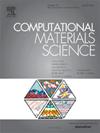从准静态原子学看有限温度晶界特性
IF 3.3
3区 材料科学
Q2 MATERIALS SCIENCE, MULTIDISCIPLINARY
引用次数: 0
摘要
晶界(GB)特性在很大程度上影响着多晶材料的机械、电气和热响应。对有限温度下晶粒边界特性的计算研究大多采用分子动力学(MD)方法,这种方法计算成本高,可访问的时间尺度范围有限,而且需要热力学积分等繁琐技术来估算自由能。这就将国标特性的合理计算(在不产生过多计算费用的情况下)限制在通常不现实的情况下,例如零温度或极高的应变率。因此,需要一种既能避免 MD 时标限制,又能提供可靠的 GB 特性估计值的模拟方法。高斯相位包(GPP)方法是一种时间粗粒度技术,可以预测有限温度下准静态极限的松弛原子结构。这项研究将高斯相位包法与计算自由能的准谐波近似相结合,用于确定金属晶界在一系列实际温度下的自由能和剪切耦合因子。通过与热力学积分和准谐波近似(QHA)的比较,验证了所提出的方法能高精度地捕捉有限温度下的松弛能 GB 结构和剪切耦合因子,而且在静水膨胀 0 K 结构上的表现明显优于 QHA。本文章由计算机程序翻译,如有差异,请以英文原文为准。
Finite-temperature grain boundary properties from quasistatic atomistics
Grain boundary (GB) properties greatly influence the mechanical, electrical, and thermal response of polycrystalline materials. Most computational studies of GB properties at finite temperatures use molecular dynamics (MD), which is computationally expensive, limited in the range of accessible timescales, and requires cumbersome techniques like thermodynamic integration to estimate free energies. This restricts the reasonable computation (without incurring excessive computational expense) of GB properties to regimes that are often unrealistic, such as zero temperature or extremely high strain rates. Consequently, there is a need for simulation methodology that avoids the timescale limitations of MD, while providing reliable estimates of GB properties. The Gaussian Phase-Packet (GPP) method is a temporal coarse-graining technique that can predict relaxed atomic structures at finite temperature in the quasistatic limit. This work applies GPP, combined with the quasiharmonic approximation for computing the free energy, to the problem of determining the free energy and shear coupling factor of grain boundaries in metals over a range of realistic temperatures. Validation is achieved by comparison to thermodynamic integration and quasiharmonic approximation (QHA), which confirms that the presented approach captures relaxed-energy GB structures and shear coupling factors at finite temperature with a high degree of accuracy, and it performs significantly better than QHA on hydrostatically expanded 0 K structures.
求助全文
通过发布文献求助,成功后即可免费获取论文全文。
去求助
来源期刊

Computational Materials Science
工程技术-材料科学:综合
CiteScore
6.50
自引率
6.10%
发文量
665
审稿时长
26 days
期刊介绍:
The goal of Computational Materials Science is to report on results that provide new or unique insights into, or significantly expand our understanding of, the properties of materials or phenomena associated with their design, synthesis, processing, characterization, and utilization. To be relevant to the journal, the results should be applied or applicable to specific material systems that are discussed within the submission.
 求助内容:
求助内容: 应助结果提醒方式:
应助结果提醒方式:


